Train your cat to like grooming means teaching your cat to enjoy being brushed, bathed (when necessary), having her ears and teeth cleaned, and claws clipped. This can be challenging, as not every cat enjoys the perfect pussycat pampering experience you’d love to give her!
Cat grooming basics include brushing your cat’s fur, bathing her (if and when required), clipping her claws, and ear and teeth cleaning. Regular grooming is important for your cat’s overall health, keeps your home fur-free, and can prevent damage to your furnishings.
Different cat breeds typically have different grooming requirements, which can mean learning new grooming techniques and how to use a new set of grooming tools, too.
Read this comprehensive guide to learn everything you need to train your feline friend to like grooming!
What Are Your Cat’s Grooming Needs?
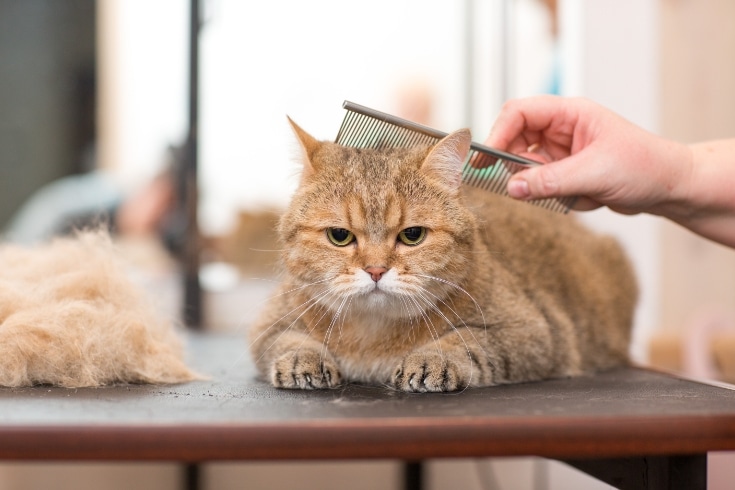
Your cat’s grooming needs depend on breed, coat type, age, and health.
Most cats constantly shed, requiring regular brushing to remove dead fur and prevent matting, and brushing your furry feline can also help to keep vacuuming your home to a minimum, especially if your cat likes to sleep on your bed or furniture.
In addition, your cat’s ears can become dirty, leaving your pet open to bacterial infections, so you’ll need to clean them fairly regularly. Cats’ claws grow like your fingernails, so they need clipping regularly to prevent overgrowth.
Outdoor cats tend to sharpen and “trim” their claws by raking them down fences and the like. However, if you have an indoor cat or a kitten not old enough to go out, you’ll need to do that job for her.
You should clean your cat’s teeth every day or two to prevent plaque and tartar from accumulating and causing long-term dental problems for your pet. Always use a specially designed cat toothbrush and toothpaste for your pet.
Finally, although bathing your cat is not really necessary, you might need to take the plunge and bathe your pet if she’s an outdoorsy type that tends to get filthy and won’t groom herself to get clean.
Why Is Regular Grooming Important For Cats?
Regular grooming for cats is essential for several reasons:
Coat Maintenance
Your cat’s fur grows constantly, and brushing her regularly helps to keep the coat clean, healthy, and free from mats and tangles.
In addition, regular brushing gets rid of loose hair, preventing your cat from ingesting it during self-grooming, thereby reducing the formation of hairballs.
Skin Health
Brushing your cat lets you spot any brewing skin problems, such as allergies, infections, or lumps and bumps.
For example, one of my cats developed a nasty abscess on his neck that wasn’t visible because of his thick coat. However, when I brushed Henry, I felt a hot lump under his skin that turned out to be a nasty abscess. Fortunately, a vet visit, lancing, and a course of antibiotics fixed the problem.
Brushing your cat helps to distribute natural skin oils throughout the coat, preventing dryness and oiliness.
Social Interaction and Bonding
The physical contact of brushing your cat helps promote bonding between you, and many cats thoroughly enjoy the calming experience of being groomed when done gently and with care.
Controls Shedding
Like dogs, cats shed their fur, especially during seasonal changes in the spring and fall. Grooming your cat regularly can help minimize the amount of loose hair in your home, reducing the risk of hair-related pet allergies and letting you keep your vacuum cleaner safely in the cupboard!
Flea And Tick Prevention
No matter how careful you are, outdoor cats can pick up fleas and ticks, bringing them back into your home as unwanted hitchhikers. Brushing your cat regularly allows you to spot any external parasites that are attacking your pet, so you can take immediate action to get rid of them and prevent the infestation from becoming more severe.
Dental Care
Cats can be especially prone to dental diseases, including gingivitis and tartar buildup, and cleaning your cat’s teeth as part of her daily grooming routine can help to promote good overall oral health and identify developing problems before they become serious.
However, some cats won’t tolerate brushing their teeth, but feeding them kibble and crunchy treats can help to scrape away the bacteria that cause plaque, and regular dental checkups at your vet clinic will help spot problems before they become serious.
What Are The Grooming Requirements Of Different Cat Breeds?
When it comes to cat grooming requirements, there’s no “one size fits all” solution!
Longhaired breeds demand more frequent brushing than their shorter-haired cousins since they’re more prone to matting, whereas hairless or extremely short-haired breeds need hardly any brushing at all.
That said, you’ll still need to keep on top of nail clipping, and your cat’s teeth should be cleaned at least every other day if your feline friend will tolerate that.
Daily Grooming
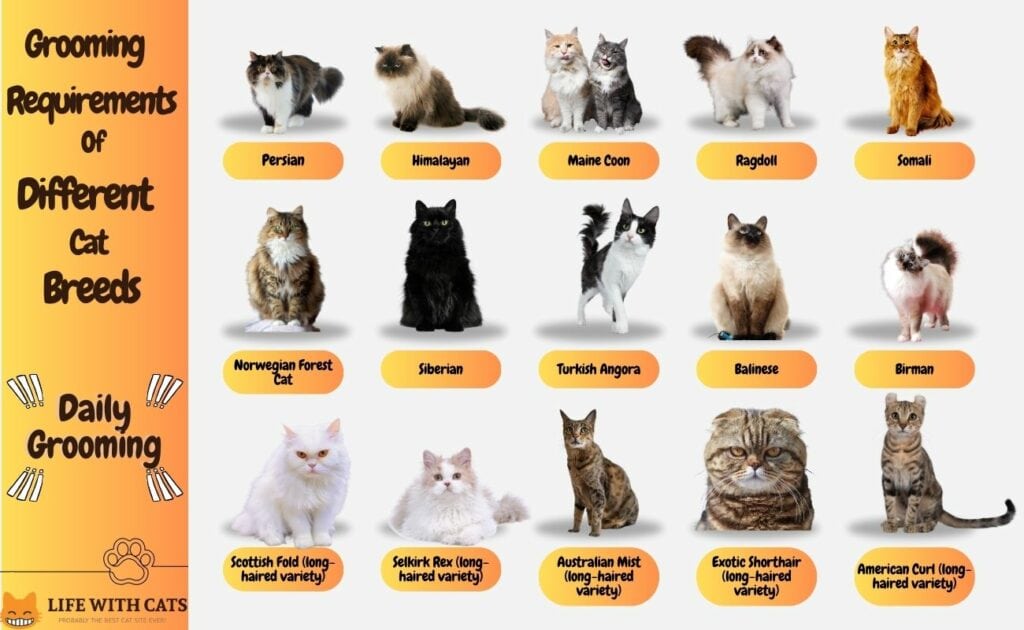
The following long-haired cat breeds all have gorgeous, long, silky coats that are extremely prone to matting and tangling.
Mats can be extremely painful for your cat if they form close to the skin and can cause infections. The best way to remove mats is to have a professional groomer clip them off, so brushing your long-haired breed cat daily to prevent mats from forming is definitely the best way to go.
- Persian
- Himalayan
- Maine Coon
- Ragdoll
- Somali
- Norwegian Forest Cat
- Siberian
- Turkish Angora
- Balinese
- Birman
- Scottish Fold (long-haired variety)
- Selkirk Rex (long-haired variety)
- Australian Mist (long-haired variety)
- Exotic Shorthair (long-haired variety)
- American Curl (long-haired variety)
Weekly Grooming

Some cats have fur that you only need to brush once a week to remove loose hair, helping to keep your home tidy and free from cat hair and prevent hairballs caused by self-grooming.
These cats have shorter coats than others and tend not to shed as much as their long-haired cousins.
- Siamese
- Bengal
- Burmese
- Russian Blue
- Abyssinian
- Cornish Rex
- Devon Rex
- British Shorthair
- Scottish Fold (short-haired variety)
- American Shorthair
- Tonkinese
- Chartreux
- Oriental Shorthair
- Singapura
- Bombay
Monthly Grooming
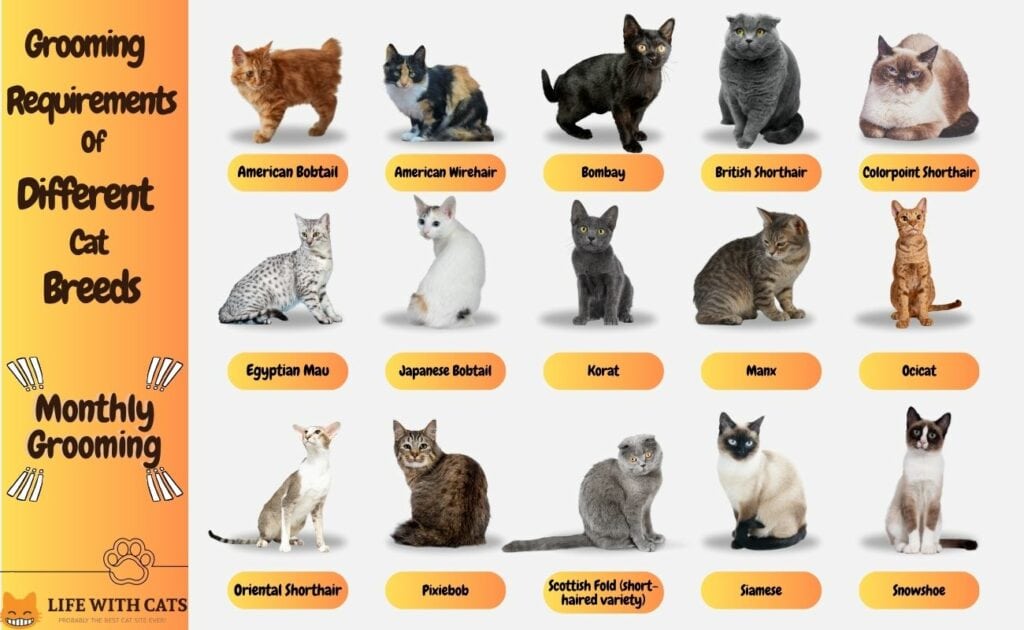
If you have a cat with much shorter hair, you can usually get away with grooming her once a month. Although these cats shed, their coats are not as prone to matting as long-haired varieties and can usually keep themselves tidy by self-grooming.
- American Bobtail
- American Wirehair
- Bombay
- British Shorthair
- Colorpoint Shorthair
- Egyptian Mau
- Japanese Bobtail
- Korat
- Manx
- Ocicat
- Oriental Shorthair
- Pixiebob
- Scottish Fold (short-haired variety)
- Siamese
- Snowshoe
Cat Breeds That Rarely Need Brushing
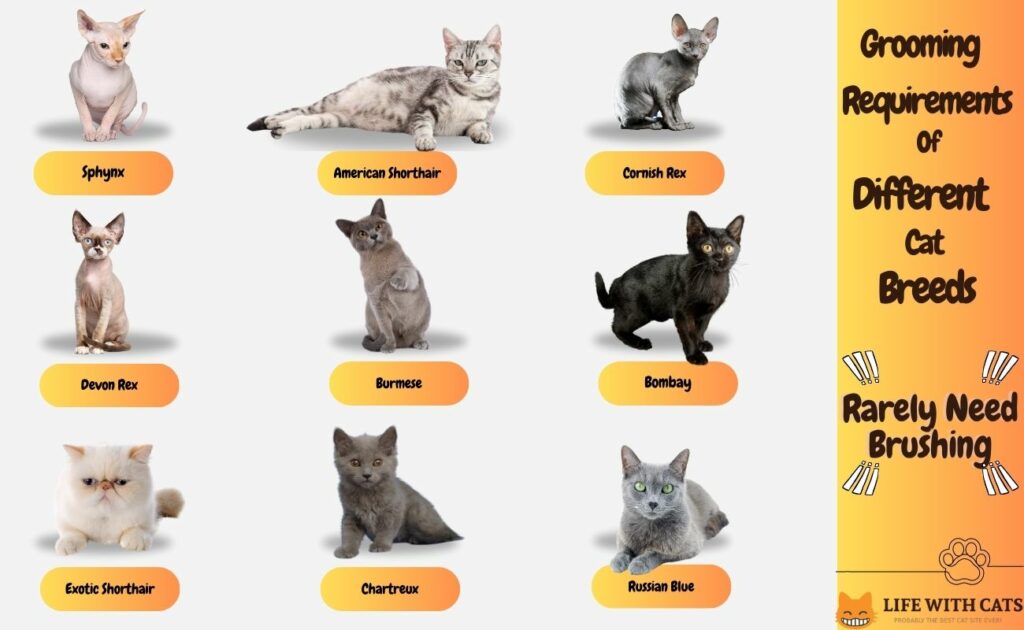
The following cat breeds have extremely short coats that don’t tend to mat, so your cat can keep herself clean and tidy by self-grooming.
However, don’t forget to clip your pet’s claws and clean her ears and teeth regularly!
- Sphynx
- American Shorthair
- Cornish Rex
- Devon Rex
- Burmese
- Bombay
- Exotic Shorthair
- Chartreux
- Russian Blue
How Do You Create A Comfortable Grooming Environment
To create a comfortable grooming environment, choose a quiet, warm room in your home where your cat feels safe, secure, and relaxed. You’ll also need to buy a set of high-quality grooming tools from a good local pet store or online supplier.
Choosing The Right Grooming Tools
Your cat will not enjoy being brushed and groomed if the tools you use to tug at her fur and make her uncomfortable.
The brush and comb you use will depend largely on the thickness and length of your cat’s fur. For example, if your cat has very thick fur with a dense, fluffy undercoat, you will need a wide-toothed comb and a stripping brush, whereas if the coat is very short, a pin brush and bristle brush should suffice.
The claw clippers you use should be specially designed for cats with a protective guard to prevent you from clipping the claws too short.
If you decide to bathe your cat, never use human shampoo, dog shampoo, or shower gel! Cats have a different skin pH to dogs and humans, and using the wrong shampoo could cause irritation and even trigger allergies. A cat’s skin is more acidic than a dog’s, having an average pH level of 6.0, whereas dog skin averages 7.5 and humans’ 5.5.
Never use human toothpaste for your cat! You can buy cat and dog toothpaste and toothbrushes from your local pet store and tooth-cleaning cat treats.
Setting Up A Calm And Quiet Space
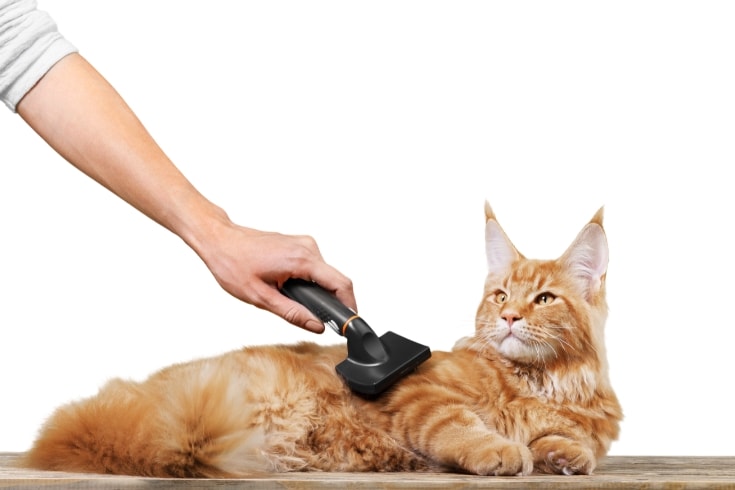
Grooming your cat should be a relaxing, pleasant experience for both of you, so you’ll need a warm, quiet room where you won’t be disturbed or interrupted.
Creating A Positive Grooming Experience
Grooming can be uncomfortable for your cat, especially if she has long fur that tends to tangle. So, you must have treats, catnip, and toys on hand to make the experience as pleasant as possible for her.
Using positive reinforcement and plenty of rewards helps your cat to associate being groomed with good things, such as treats and affection, helping to offset any discomfort the session might cause.
What Are The Different Grooming Techniques?
The different grooming techniques you’ll use follow the same routine for every cat: brush her fur, clean her teeth, clip her nails, and clean her ears.
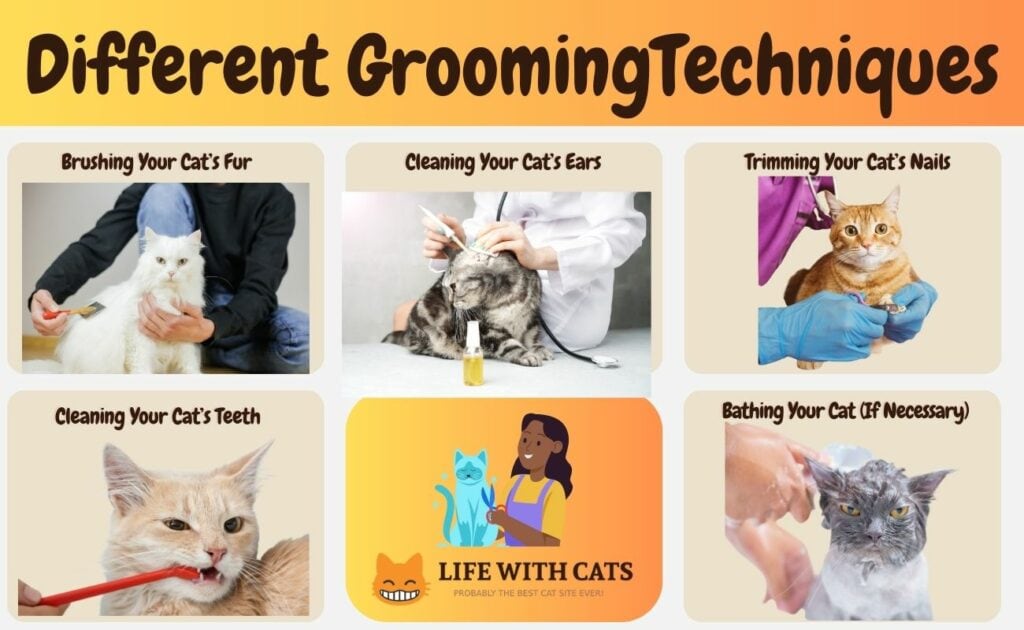
Brushing Your Cat’s Fur
First, you must choose the right cat brush for your pet’s coat.
Many different types of brushes are available, including slicker brushes, bristle brushes, and grooming gloves.
The type of brush you use depends on the texture and length of your pet’s fur, so if you’re not sure what to go for, ask your vet or a pro groomer what the best cat brushes are for your cat.
Before you begin, allow the cat to sniff the brush and familiarize herself with it so that she’s not nervous when you start using it on her coat. Start brushing your cat’s fur, using gentle slow strokes, following the direction of hair growth, and working from the cat’s head down to her tail. Use very light pressure around sensitive areas, and if your cat shows signs of discomfort, take a break and try again later.
As you groom your cat, loose hair will accumulate on the brush, and you’ll need to periodically remove it and discard it to prevent the brush from becoming clogged. Remove tangles using your fingers and some detangling spray, taking care not to pull at the hair, which would be very uncomfortable for your cat.
Throughout your grooming session, be sure to offer your cat plenty of treats and praise her so that she associates being brushed with something good happening.
Cleaning Your Cat’s Ears
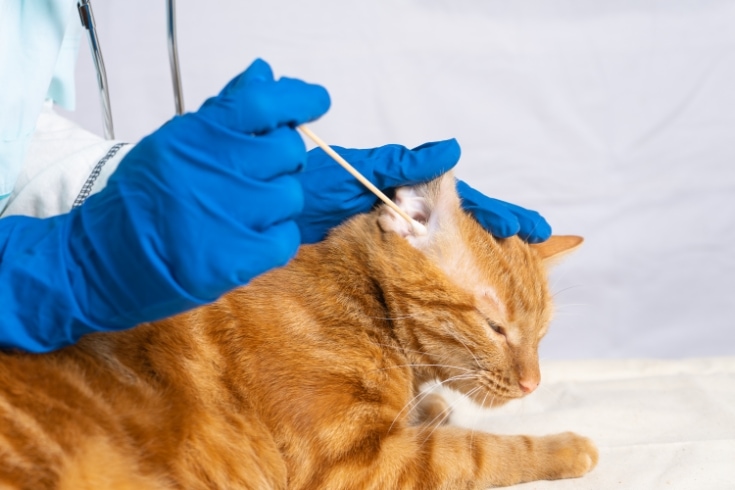
Start by getting your cat used to the sensation of having her ears touched by gently massaging them during petting sessions, and give your pet plenty of praise and treats to create a positive association with having her ears touched.
Before you clean them, look closely at your cat’s ears for any signs of discharge, inflammation, or debris, and if you spot anything concerning, consult a vet immediately.
Read the instructions carefully on the ear cleaner solution, then gently squeeze the ear solution into the cat’s ear canal, avoiding inserting the tip of the bottle deep inside the ear. Massage the base of the cat’s ear for about 30 seconds to distribute the cleaner and loosen any wax or debris inside the ear.
Use a cotton bowl or gauze pad wrapped around your finger to gently wipe the visible parts of the ear canal to get rid of any loosened wax or debris. Never insert anything deep inside the ear canal which might injure your cat.
Trimming Your Cat’s Nails
If you have an indoor cat, you might need to trim her nails every four to six weeks, although if your cat uses a scratching post or mat, her claws should remain short enough. In fact, most cat owners mainly trim their pet’s nails to blunt them so that the cat cannot cause damage to furnishings or floor coverings in the home.
Use a pair of cat nail clippers to do this job, not your own toenail clippers! Pet nail clippers have a guard that prevents you from clipping the nail too short and damaging the quickly, which is extremely painful for the cat.
Some cats tolerate having their nails trimmed while others do not; it’s really just a case of getting your cat used to having her feet touched and rewarding her with praise and treats for good behavior.
To clip each nail, gently push the sheath back to reveal the nail beneath, position the clippers with the guard set, and clip the nail.
Bathing Your Cat (If Necessary)
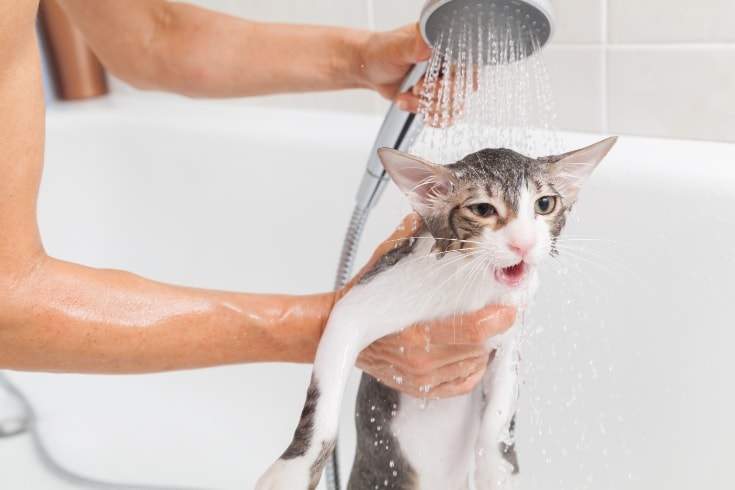
Not all cats require bathing, and the only time I have ever bathed one of my cats was when I took in a stray that was infested with fleas and the vet prescribed a special flea shampoo for her.
However, if your cat lives outside and gets very dirty or arrives home covered in something unpleasant, you might need to bathe her.
When bathing a cat, run a couple of inches of lukewarm water into your sink and gently place the cat in it. Use a plastic cup to pour a little water over the cat, starting on her back and working down toward her tail. Take a small amount of shampoo and gently massage it into her fur. Rinse the shampoo out of the fur, ensuring the water runs clear, and no shampoo is left.
Don’t pour water over the cat’s head! Instead, use a damp cloth to wipe her fur to remove dirt from her head and eyes.
Dry your cat thoroughly using a warm, fluffy towel or a cat bathing bag. Don’t be tempted to allow your cat to air-dry, as that can lead to her getting chilled.
Cleaning Your Cat’s Teeth
You can use a special cat toothbrush and toothpaste or a finger brush to clean your cat’s teeth. Pet toothpaste is usually poultry or fish flavored, so pick one your cat likes. Squeeze a small amount of toothpaste onto the brush and allow your cat to sniff and lick it.
Often, the cat will start chewing the brush to get at the tasty toothpaste on it, which saves you from trying to brush her teeth! In fact, my vet told me not to worry too much about scrubbing the cat’s teeth as long as she chewed the brush with the toothpaste on it.
What Are The Things You’ll Need To Train Your Cat To Like Grooming
The things you’ll need to train your cat to like grooming are treats, a clicker device, a selection of interactive toys, and plenty of patience!
Treats
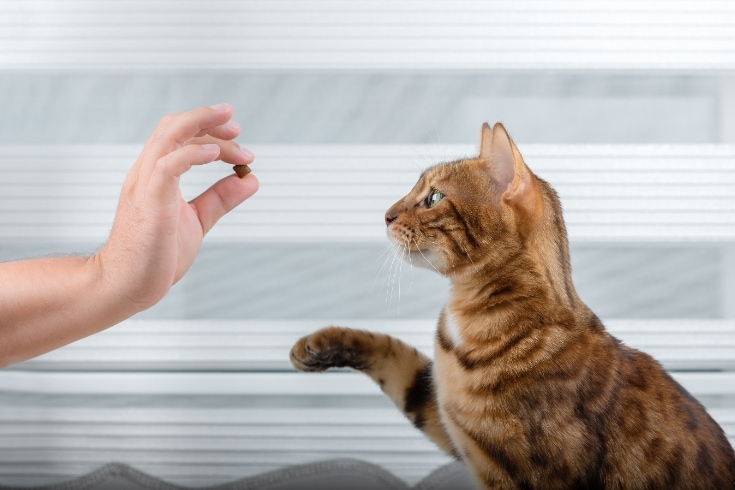
Keep a small pouch of your cat’s favorite treats on hand to reward her for good behavior during the grooming session.
Clicker
If you’re using a clicker device for your training sessions, you must have it handy. However, using a clicker while simultaneously grooming your cat could be challenging, as you’ll probably need both hands free to hold your pet!
Interactive Toys
If your cat doesn’t like edible treats, and not all do, you could break off from grooming periodically to play with your pet using one of her favorite interactive toys.
Comfortable Grooming Area
There’s no point trying to groom your cat in a busy area with lots of distractions. So, before you begin, choose a comfortable, warm room in your home where you and your cat can enjoy some quality time without interruption.
Calming Aids (Optional)
Some cats hate being groomed and will go to great lengths to prevent you from brushing them! Sometimes, a pheromone calming aid can help to settle and relax your cat for her grooming session.
Catnip also works quite well for some cats. I once had a cat that would pretty much zone out after he’d enjoyed a roll on a mat covered in catnip, which worked perfectly at ear-cleaning time!
Patience And Consistency
Be patient when grooming your cat, and reward her with treats and praise throughout the process. Positive reinforcement and consistency are the keys to successful cat grooming sessions!
Can You Train Your Cat To Like Grooming?
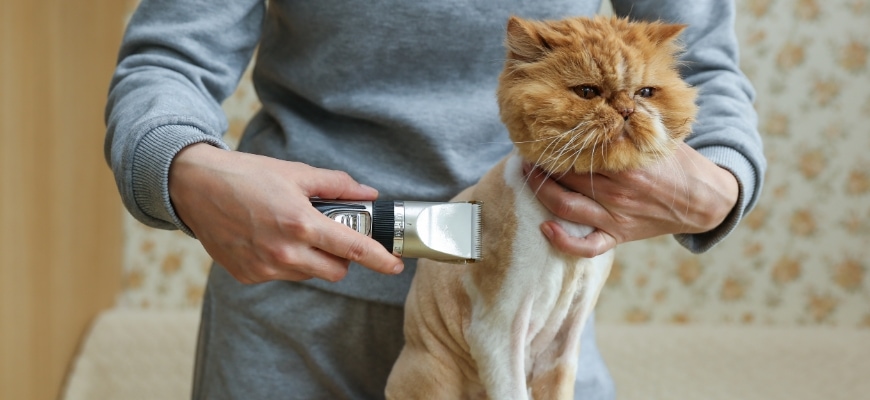
Yes, you can train your cat to like grooming!
Cats being held in the wrong way will become uncomfortable, fidget, and try to escape, so before you begin, make sure you know how to handle and hold a cat properly. If you’re unsure how to do that, ask your vet nurse to show you.
Start With Positive Associations
First of all, teach your cat to associate being groomed with receiving treats, praise, and cuddles. That way, your kitty learns that grooming time comes with plenty of nice things and is something to look forward to.
Gentle Touch And Handling
Handle your cat gently during all aspects of the grooming process, and be careful to touch sensitive areas with gentleness and care.
Gradual Introduction Of Grooming Tools
Don’t suddenly start brushing your cat or try to clean her ears without doing some groundwork first!
Take time to gradually introduce all the grooming tools you’re going to use so that your pet isn’t afraid, suspicious, or resentful of them when you use them on her.
Use Positive Reinforcement
Throughout the grooming process, always use positive reinforcement and reward-based training techniques. That way, your cat learns to associate being handled, brushed, bathed, having her ears cleaned, and claws clipped with nice things, such as receiving edible treats, enjoying being petted, or playing a favorite game.
Take Small Steps
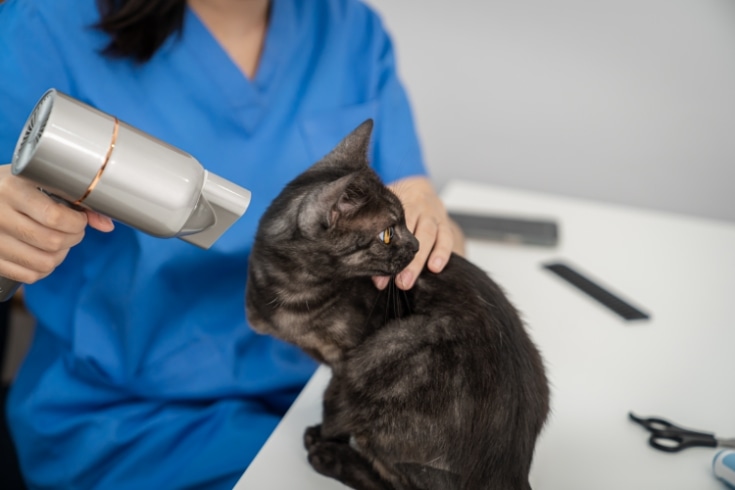
Until your cat accepts being brushed, be prepared to take small steps, and don’t rush ahead to try to complete the whole grooming process in one session.
Make It Enjoyable
Grooming time should be enjoyable for both you and your cat, so remember to use positive reinforcement methods and include plenty of praise, treats, and downtime throughout each session.
Patience And Consistency
As with all your cat training sessions, be extremely patient with your cat and keep your behavior and verbal cues consistent throughout.
Seek Professional Help If Needed
As we mentioned previously, not all cats enjoy being groomed, especially if they have come from a shelter, having lived wild on the streets for some time. If you struggle to brush and groom your cat effectively, don’t be afraid to seek professional help from a vet or experienced groomer.
Once the cat has overcome her initial fear or resentment at being groomed and learns to associate the process with good things, you should find it much easier to do the job yourself.
What Are Some Frequently Asked Questions On Training A Cat To Like Grooming?
Here are some of the answers to some of the most frequently asked questions on training a cat to like grooming.
How Long Does It Take To Train A Cat To Enjoy Grooming?
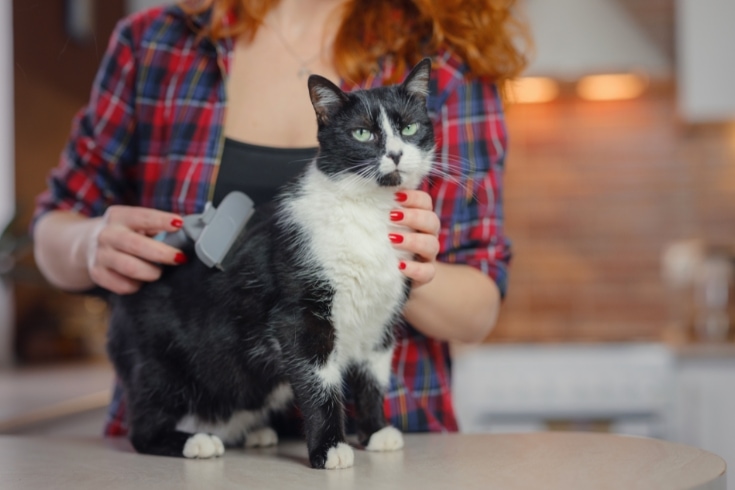
As with any new experience, the length of time it takes to train a cat to enjoy grooming varies between individuals. Generally, kittens and young cats take to being groomed more quickly than older cats and those that have come from a shelter and have uncertain history.
However, in my many years of experience in cat ownership, most of my cats enjoyed being groomed pretty much straight away.
What If My Cat Is Fearful Or Aggressive During Grooming Sessions?
If your cat is afraid or becomes aggressive during grooming sessions, take a few steps back and work out what triggers that behavior.
For example, you might need to start the process of brushing your cat all over again by letting her sniff the brushes, or you might find that claw clipping and ear cleaning are best left to a professional until your cat accepts those aspects of the grooming process.
Can I Use Treats To Encourage My Cat During Grooming?
Yes, we recommend using edible treats to encourage your cat to relax during grooming as part of the positive reinforcement reward-based training technique.
How Often Should I Groom My Cat?
How often you groom your cat depends on her coat length and texture. Generally, long-haired cats’ coats are more prone to matting and tangling, so they should be groomed every day, whereas cats with shorter coats can be groomed once a week.
If you decide to clip your cat’s claws, they generally need to be done once every four to six weeks. I check my cats’ ears once a week and clean them if necessary, and I try to clean their teeth every day or two.
Are There Any Grooming Techniques Or Tools I Should Avoid?
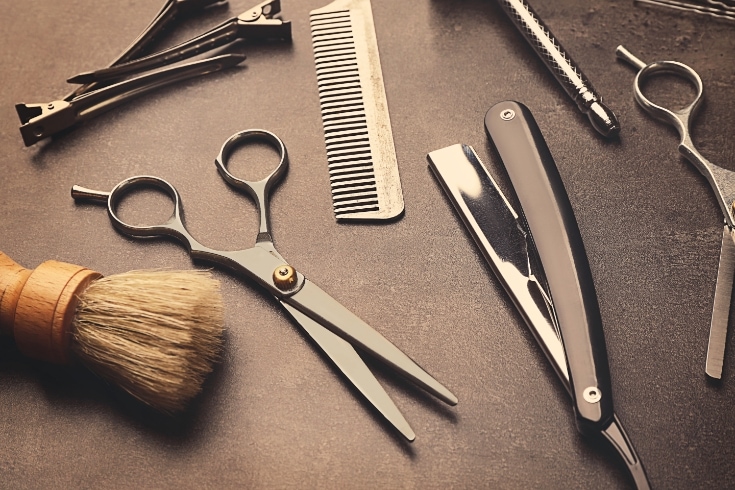
- Do not shave or cut your cat’s fur very short, as that can disrupt the coat’s natural insulation, leaving the cat vulnerable to temperature extremes. Only shave your cat’s fur if recommended to do so by your vet for medical reasons.
- Never use human or dog grooming products such as shampoo, conditioner, or perfume on your cat, as they can harm the skin and coat.
- Dry shampoo can be handy for a quick touch-up but do not use these products too much, as they can cause skin irritation and dryness.
- Do not use sharp or unsafe tools, such as scissors or nail clippers, on your cat, as accidental injuries and cuts can easily occur if the cat fidgets at just the wrong moment.
For safety reasons, only use cat-specific products and grooming tools on your cat.
Do Cats Like Being Brushed?
Yes, most cats like being brushed, especially if the experience is accompanied by plenty of their favorite edible treats, cuddles, and a treasured toy!
Do Cats Like Being Picked Up?
Not all cats like being picked up, largely because their primary means of defense is to run away. If you pick up your cat, you automatically remove her means of escape should she feel threatened, and that will probably cause your cat to wriggle, and she might even scratch you.
Why Doesn’t My Cat Like To Be Held?
The reason some cats don’t like to be held is essentially the same as the reason they don’t like being picked up. The cat feels confined and unable to escape if something startles her or she feels threatened or afraid.
Conclusion
I hope you enjoyed our guide on how to train your cat to like grooming. If you found the article helpful, please take a moment to hit the share button before you go!
Training your cat to like grooming means teaching your pet to enjoy being brushed, having her claws clipped, ears cleaned, and being bathed when necessary. When it comes to brushing your cat, different cat breeds have different requirements, meaning you’ll need to use a variety of brushes and grooming tools.
Cat grooming basics include brushing your cat’s fur, clipping her claws, and cleaning her teeth and ears. Regular grooming is essential for your cat’s overall health and well-being, as well as keeping your home free from shed fur and preventing damage to your home furnishings.
Does your cat enjoy being brushed? Tell us in the comments box below!